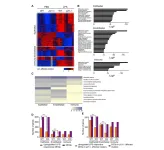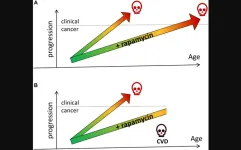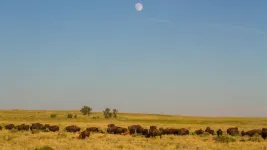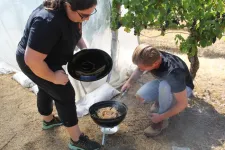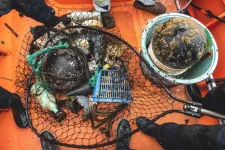(Press-News.org) Vikings occupied Greenland from roughly 985 to 1450, farming and building communities before abandoning their settlements and mysteriously vanishing. Why they disappeared has long been a puzzle, but a new paper from the Department of Earth and Planetary Sciences (EPS) determines that one factor – rising sea level – likely played a major role.
“There are many theories as to what exactly happened” to drive the Vikings from their settlements in Greenland, said Marisa J. Borreggine, lead author of the “Sea-Level Rise in Southwest Greenland as a Contributor to Viking Abandonment,” which published this week [4/17] in Proceedings of the National Academy of Sciences (PNAS). “There's been a shift in the narrative away from the idea that the Vikings completely failed to adapt to the environment and toward arguments that they were faced with a myriad of challenges, ranging from social unrest, economic turmoil, political issues, and environmental change,” said Borreggine, a doctoral candidate in the Harvard Griffin GSAS in EPS.
“The changing landscape would’ve proven to be yet another factor that challenged the Viking way of life. Alongside these other challenges,” said Borreggine, who works in the Mitrovica Group led by Frank B. Baird, Jr. Professor of Science Jerry X. Mitrovica. This likely led “to a tipping point before they abandoned the settlement.”
The departure of these Viking settlers coincided with the beginning of the period known as the Little Ice Age, which had a particular impact on the North Atlantic. But while cooling and freezing might seem likely to lower sea levels, a variety of factors combined to have the opposite effect in Greenland.
With the waters of the North Atlantic, “contributing to that new ice volume, intuition might suggest that sea level should go down,” Borreggine noted. However, a closer look at previously published geomorphological and paleoclimate data and the researchers’ modeling of ice-sheet growth suggested that the opposite occurred in Greenland, focusing on the Vikings’ Eastern Settlement. “What we study in our group is glacial isostatic adjustment, a process that leads to changes in the gravitational field, the rotation axis, and crustal deformation as the ice grows or melts,” said Borreggine.
In a first for this kind of research “we were able to apply that analysis of non-uniform sea-level change and more accurate sea-level physics to this longstanding archeological question of, ‘Why exactly did Vikings abandon the Eastern Settlement?’”
What the researchers found was striking: Not only were sea levels drawn up by gravity, other factors – including the subsidence of Greenland’s land mass – made the settlement more prone to flooding.
Focusing on the period of Viking habitation from 1000 to 1450, “there’s already a background trend of sea-level rise upon Viking arrival in the Eastern Settlement,” they said. “It's been rising for a few thousand years.” But there’s also a local effect: “crustal subsidence, or the sinking of land and the gravitational pull of water toward the growing ice sheet.”
“Not only do you have the ground being pushed down, you also have the sea surface going up,” Borreggine noted. “It’s a double whammy.”
During this period, researchers found that the settlers experienced “up to 3.3 meters of sea-level rise throughout their occupation.” For comparison’s sake, “that’s two to six times the rate of 20th-century sea-level rise. So it was pretty intense,” they said.
Archaeological research into the life of the Vikings who settled in Greenland together with this novel application of sea-level science fleshed out this compelling story. Noting the partially drowned ruins of a Viking warehouse, Borreggine pointed out that one analysis done by the group found that 75 percent of Viking sites are within a thousand meters of an area of flooding. “This flooding was pervasive.”
The impact of rising seas can also be seen in the changing diet of the Vikings, as they shifted from their own agricultural products to more marine-based foods, perhaps as their fields became saturated with salt or flooded. Such a shift, said Borreggine, reveals “they were attempting to adapt to the rising sea level.”
This paper “shows the advantages of interdisciplinary research, bringing ideas from one field to another and contributing powerful new insights,” said Mitrovica. Borreggine “has shown that in addition to the various challenges the Vikings faced as the climate descended into the ice age, they also faced pervasive flooding — an insight that only someone like Marisa, with deep expertise in the sea-level physics, could have had.”
If the lasting impact of sea-level rise sounds familiar in understanding current efforts to mitigate climate change, Borreggine noted the parallels – and one major difference. “The Vikings didn't really have a choice,” they said. “They couldn't stop the Little Ice Age. We can do work to mitigate climate change. The Vikings were locked into it.”
END
Sea-level rise in southwest Greenland as a contributor to Viking abandonment
2023-04-17
ELSE PRESS RELEASES FROM THIS DATE:
SWOG researchers report results in rare gynecologic cancers from DART immunotherapy trial
2023-04-17
Results from the S1609 DART clinical trial, which tested an immunotherapy combination of ipilimumab plus nivolumab in 53 cohorts of patients with rare cancers, are being reported for five cohorts of patients who had rare gynecologic cancers.
In three of those five cohorts – the cohorts for clear cell ovarian cancer; small cell ovarian carcinoma, hypercalcemic type; and non-epithelial ovarian cancer – some patients have shown durable responses to the immunotherapy, including several patients whose complete remissions have now lasted more than three years.
The findings will be presented in three abstracts at the 2023 ...
Can you describe a sensation without feeling it first?
2023-04-17
Blind or colorblind people can describe colors and use expressions like “green with envy” or “feeling blue.” A hearing-impaired person can also say those same vibrant hues are “loud.” But many linguists and cognitive neuroscientists have assumed that somatosensation—touch, pain, pressure, temperature, and proprioception, or the sense of where your body is oriented in space—is fundamental for understanding metaphors that have to do with tactile sensations. Understanding expressions like “she is having a tough time” or “that class was hard,” it was believed, requires previous experience with those sensations to extend ...
p21 facilitates chronic lung inflammation via epithelial and endothelial cells
2023-04-17
“Our results implicate p21 as a critical regulator of chronic bronchitis and a driver of chronic airway inflammation and lung destruction.”
BUFFALO, NY- April 17, 2023 – A new research paper was published on the cover of Aging (listed by MEDLINE/PubMed as "Aging (Albany NY)" and "Aging-US" by Web of Science) Volume 15, Issue 7, entitled, “p21 facilitates chronic lung inflammation via epithelial and endothelial cells.”
Cellular senescence is a stable state of cell cycle arrest that regulates tissue ...
International clinical trial conducts head-to-head comparison of open versus minimally invasive surgery for early-stage cervical cancer
2023-04-17
COLUMBUS, Ohio – Gynecologic surgeons with The Ohio State University Comprehensive Cancer Center – Arthur G. James Cancer Hospital and Richard J. Solove Research Institute (OSUCCC – James) are leading an international clinical trial to determine whether minimally invasive surgery robotic surgery is better or worse than open surgery when performing a radical hysterectomy to treat cervical cancer.
Although minimally invasive and robotic-assisted surgery techniques have become the standard approach for many surgeries, in gynecologic cancer open surgery – which involves one ...
nPOD honors Estefania Quesada Masachs for type 1 diabetes discoveries
2023-04-17
LA JOLLA, CA—La Jolla Institute for Immunology (LJI) Instructor Estefania Quesada Masachs, M.D., Ph.D., has won the 2023 Young Investigator of the Year Award from the Network for Pancreatic Organ donors with Diabetes (nPOD). This prestigious award recognizes Quesada Masachs' groundbreaking research in type 1 diabetes.
Quesada Masachs says she was "happily surprised" to receive the award from nPOD at their 2023 conference. The organization provides pancreatic tissue samples to researchers, opening the door for in-depth research into type 1 diabetes, an autoimmune disease where the body's own immune ...
Cancer prevention with rapamycin
2023-04-17
“[...] long-term treatment with rapamycin slows down aging, a major risk factor for cancer [...]”
BUFFALO, NY- April 17, 2023 – A new research perspective was published in Oncotarget's Volume 14 on April 14, 2023, entitled, “Cancer prevention with rapamycin.”
The mTOR (Target of Rapamycin) pathway is involved in both cancer and aging. Furthermore, common cancers are age-related diseases, and their incidence increases exponentially with age. In his new research perspective, Mikhail V. Blagosklonny, M.D., Ph.D., from Roswell Park Comprehensive Cancer Center discusses rapamycin and other rapalogs and their ...
Temperature, drought influencing movement of Plains bison
2023-04-17
It epitomizes the Great Plains in spirit and in form: a 2,000-pound tank on hooves, cloaked in shaggy winter-tested coat, capped by horns acting as warning and weapon.
Even its scientific name, Bison bison bison, seems to conjure an echo worthy of its majesty. Still, the implacable profile of the Plains bison — the national mammal of the United States and largest on the continent — belies the vulnerability in its history, which saw its legions decimated from tens of millions to just a few hundred in the span of a few colonial centuries.
Conservation efforts have pushed its number back to roughly 20,000, and its status from endangered ...
Oregon State researchers make breakthrough in understanding the chemistry of wildfire smoke in wine
2023-04-17
CORVALLIS, Ore. – Oregon State University researchers have discovered a new class of compounds that contributes to the ashy or smokey flavors in wine made with grapes exposed to wildfire smoke.
This development is significant for winemakers who have struggled to combat the impact of smoke on grapes at a time when climate change is leading to an increase in the number and severity of wildfires, the researchers said.
“These findings provide new avenues for research to understand and prevent smoke taint in grapes,” said Elizabeth Tomasino, an associate professor of enology ...
Coastal species persist on high seas on floating plastic debris
2023-04-17
The high seas have been colonized by a surprising number of coastal marine invertebrate species, which can now survive and reproduce in the open ocean, contributing strongly to the floating community composition. This finding was published today in Nature Ecology and Evolution by a team of researchers led by the Smithsonian Environmental Research Center (SERC) and the University of Hawai‘i (UH) at Mānoa.
The researchers found coastal species, representing diverse taxonomic groups and life history traits, in the eastern North Pacific Subtropical Gyre on over 70 percent of the plastic debris ...
UCF researchers create digital map of sympathetic nervous system
2023-04-17
UCF Researchers Create Digital Map of Sympathetic Nervous System
A team of UCF College of Medicine researchers has created a digital topographical map of the cardiac sympathetic neural network, the region that controls the body’s heart rate and its “fight-or-flight” response. They hope this map will eventually serve as a guide to treat cardiovascular conditions using bioelectronic devices.
The study, led by Dr. Zixi Jack Cheng, a neuro-cardiovascular scientist, was published in the Scientific Reports journal ...
